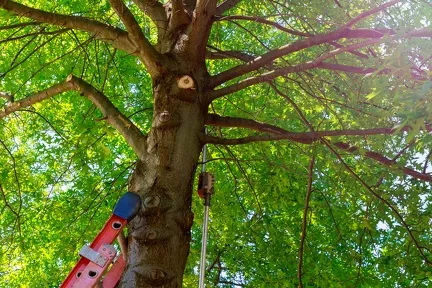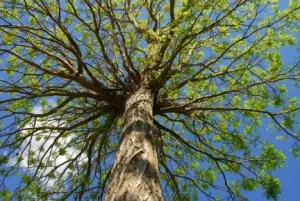When selecting trees for your landscape, it’s essential to consider their maintenance requirements. While many trees are relatively low-maintenance, some species require significant care to thrive. Here are 11 trees that require too much care and might be more trouble than they’re worth for the average homeowner. For more information on tree care and services, visit our Home Page and Service Pages.
1. Silver Maple (Acer saccharinum)
Silver maples are fast-growing trees, which might seem like an advantage, but their rapid growth leads to weak wood that is prone to breaking during storms. Additionally, their invasive roots can damage sidewalks, driveways, and plumbing systems.
- Weak Wood: Prone to breaking, leading to frequent clean-up and potential property damage.
- Invasive Roots: Can damage infrastructure and plumbing.
2. Bradford Pear (Pyrus calleryana)
The Bradford pear is notorious for its beautiful spring blossoms, but it has several drawbacks. Its branches are weak and prone to splitting, especially during storms. Moreover, it produces unpleasant-smelling flowers and has invasive tendencies.
- Weak Branches: Frequently split and break.
- Invasive Nature: Spreads aggressively, outcompeting native species.

3. Leyland Cypress (Cupressus × leylandii)
Leyland cypress trees grow quickly and are often used for privacy screens. However, they are highly susceptible to diseases and pests, which can lead to significant maintenance issues.
- Disease-Prone: Susceptible to canker diseases and root rot.
- Pest Problems: Attracts various pests that can cause damage.
For professional advice on dealing with tree diseases and pests, visit our Tree Health Services.
4. Weeping Willow (Salix Babylonic)
Weeping willows are visually striking with their drooping branches, but they require a lot of water and are prone to pests and diseases. Their extensive root systems can also cause damage to nearby structures.
- High Water Needs: Requires constant moisture.
- Root Damage: Invasive roots can harm foundations and pipes.
5. Black Walnut (Juglans nigra)
The black walnut tree produces a toxin called juglone, which can inhibit the growth of other plants around it. Additionally, it produces messy fruit that requires regular clean-up.
- Toxic to Plants: Juglone inhibits growth of nearby vegetation.
- Messy Fruit: Requires frequent clean-up.
6. Eastern White Pine (Pinus strobus)
Eastern white pines are majestic trees, but they drop large amounts of needles, cones, and sap, making them a high-maintenance choice. They are also susceptible to several pests and diseases.
- Debris: Constantly drops needles and cones.
- Pest and Disease Susceptibility: Attracts pests and is prone to disease.
7. Sweetgum (Liquidambar styraciflua)
The sweetgum tree is known for its beautiful fall foliage, but it produces spiky seed pods that can be a nuisance. These seed pods require regular clean-up and can be hazardous if stepped on.
- Messy Seed Pods: Requires frequent clean-up.
- Trip Hazard: Spiky pods can be dangerous.
8. Mimosa (Albizia julibrissin)
Mimosa trees have lovely, fragrant flowers, but they are highly invasive and short-lived. They are also susceptible to several diseases and pests, which can lead to constant care requirements.
- Invasive: Spreads quickly and aggressively.
- Disease and Pest Issues: Requires frequent treatment.
For help managing invasive tree species, explore our Tree Removal Services.

9. Eucalyptus (Eucalyptus spp.)
Eucalyptus trees are known for their aromatic leaves, but they can be messy, dropping bark and leaves year-round. They are also highly flammable, making them a poor choice in fire-prone areas.
- Constant Debris: Drops leaves and bark regularly.
- Fire Hazard: Highly flammable, increasing fire risk.
10. Poplar (Populus spp.)
Poplar trees grow quickly, but their wood is weak and prone to breaking. They also have invasive root systems that can cause damage to nearby structures and require significant maintenance.
- Weak Wood: Prone to breaking and storm damage.
- Invasive Roots: Can harm foundations and pipes.
11. Russian Olive (Elaeagnus angustifolia)
The Russian olive is a hardy tree, but it is highly invasive and can quickly take over an area. It also produces sharp thorns and messy fruit, making it difficult to manage.
- Invasive: Spreads aggressively, outcompeting native species.
- Thorns and Fruit: Sharp thorns and messy fruit require regular care.
Conclusion
Choosing the right trees for your landscape is crucial to minimize maintenance and ensure a healthy, beautiful yard. While these 11 trees require too much care, there are plenty of other options that are more manageable. For professional tree care services and advice, visit Bieniek Tree Services. Our experts can help you select the best trees for your property and provide the care they need to thrive.
For more information, visit our Home Page and Service Pages to learn more and schedule your tree care service today.
